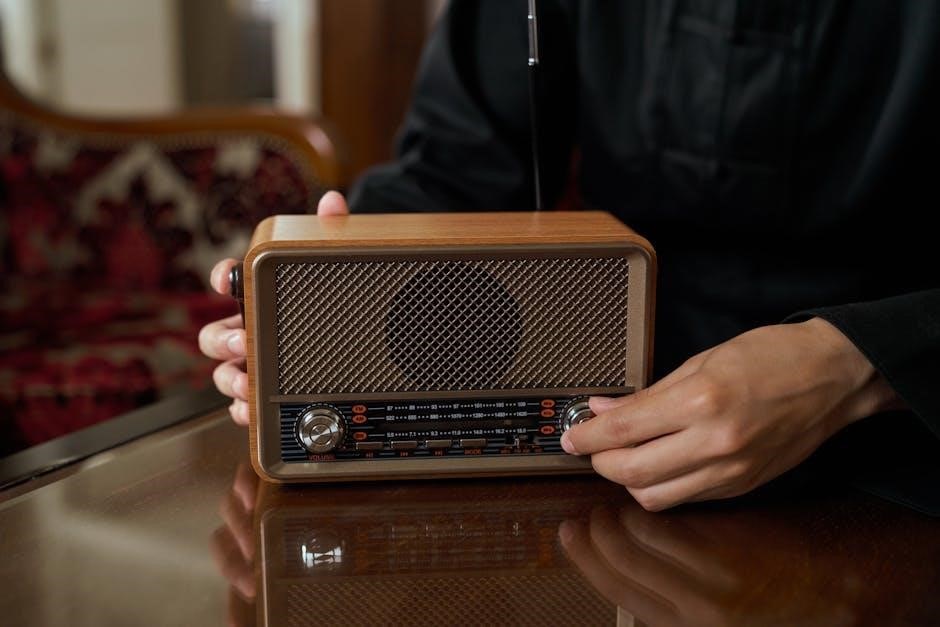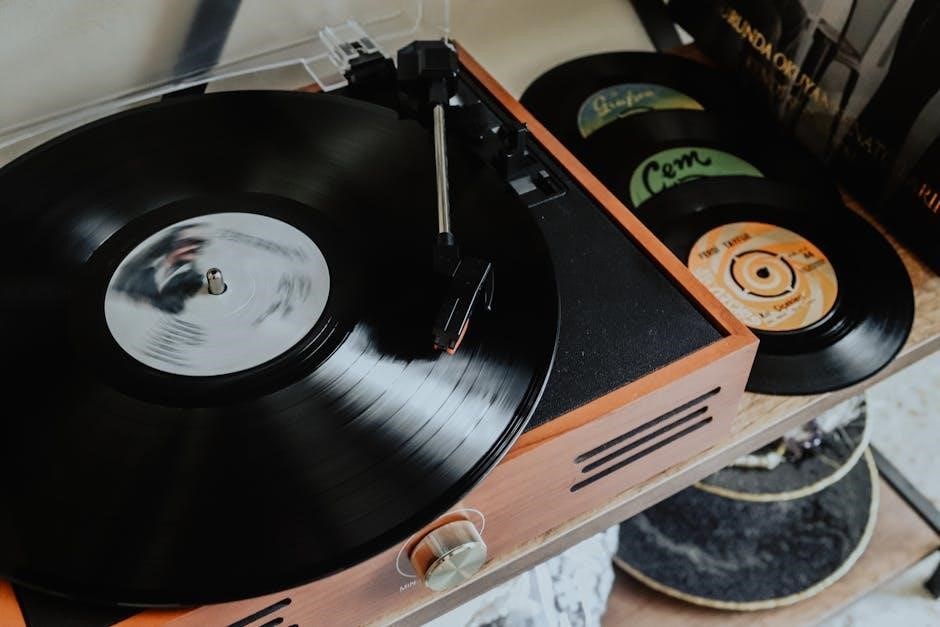
The K25 LP throttle adjustment is crucial for optimal engine performance, fuel efficiency, and longevity. This guide provides a step-by-step process to ensure proper calibration for smooth operation.
1.1 Importance of Proper Throttle Adjustment
Proper throttle adjustment is essential for ensuring smooth engine operation, optimal performance, and fuel efficiency in the K25 LP engine. Correct calibration prevents issues like engine stalling, uneven idle, and poor throttle response. It also ensures the engine runs within the manufacturer’s specified RPM range, reducing wear and tear on internal components. Improper adjustment can lead to decreased power output, increased fuel consumption, and potential damage to the engine over time. Additionally, accurate throttle settings are critical for maintaining emissions standards and overall safety. Neglecting this process can result in long-term mechanical problems, requiring costly repairs; Regular and precise throttle adjustment is therefore vital for maintaining the longevity and reliability of the K25 LP engine.
1.2 Safety Precautions Before Adjustment
Before attempting throttle adjustment on the K25 LP engine, ensure all safety precautions are followed to avoid accidents or engine damage. Disconnect the battery to prevent accidental engine start-up and engage the parking brake to secure the vehicle. Allow the engine to cool down completely to avoid burns or injuries. Wear protective gear, including gloves and safety glasses, to safeguard against potential hazards. Consult the service manual for specific guidelines and ensure the workspace is well-ventilated. Never adjust the throttle while the engine is running or hot, as this can lead to unpredictable behavior. Improper adjustment can result in engine instability or safety risks, so proceed with caution and precision. Always double-check adjustments to ensure reliability and performance.

Tools and Materials Required
Essential tools include a screwdriver, pliers, torque wrench, tachometer, and cleaning supplies. Additional materials like new gaskets or throttle cable lubricant may be needed for adjustments.

2.1 Essential Tools for Throttle Adjustment
The essential tools for K25 LP throttle adjustment include a screwdriver for adjusting screws, pliers for throttle cable adjustments, and a torque wrench for precise tightening. A tachometer is necessary to measure idle RPM accurately, while cleaning supplies like carburetor cleaner and rags help maintain the throttle body. Additionally, a multimeter may be needed for diagnosing electrical issues with the throttle position sensor. These tools ensure precise and safe adjustments, preventing potential damage to engine components. Proper tool selection is critical for achieving optimal throttle calibration and maintaining engine performance. Always refer to the service manual for specific tool recommendations tailored to your K25 LP engine model.
2.2 Recommended Materials for Calibration

For effective K25 LP throttle calibration, gather materials like a cleaning kit for the throttle body, including carburetor cleaner and a soft brush. Fuel additives can help maintain proper combustion during testing. A silicone-based lubricant is recommended for the throttle cable to ensure smooth operation. Additionally, a set of feeler gauges may be necessary for precise adjustments. Always use high-quality materials to prevent contamination and ensure optimal performance. These materials will help maintain your engine’s efficiency and extend its lifespan. Proper calibration requires attention to detail and the right supplies to achieve accurate results.

Locating Key Components
The throttle body houses the throttle plate, controlling airflow. The idle speed adjustment screw sets the engine’s RPM. The throttle cable connects to the accelerator pedal properly.
3.1 Throttle Body and Throttle Plate
The throttle body is a critical component that houses the throttle plate, regulating airflow into the engine. The throttle plate is positioned to control the air-fuel mixture, ensuring efficient combustion. Proper alignment and movement of the throttle plate are essential for smooth engine operation. It is connected to the throttle cable, which transmits pedal input to the engine. Any obstruction or malfunction in the throttle body can lead to poor performance, such as rough idling or reduced acceleration. Regular inspection and cleaning of the throttle body are recommended to maintain optimal airflow and prevent issues. Always refer to the service manual for specific guidance on handling these components.
3.2 Idle Speed Adjustment Screw
The idle speed adjustment screw plays a vital role in maintaining stable engine operation at low RPM. Located on the throttle body, this screw regulates the airflow when the throttle is closed, ensuring a smooth idle. Proper adjustment is essential to prevent engine stalling or rough running. Turning the screw clockwise typically increases the idle speed, while counterclockwise decreases it. It’s important to follow the manufacturer’s specifications for the correct idle RPM. Misadjustment can lead to poor fuel efficiency or emissions issues. Always ensure the screw is adjusted with the engine warmed up and in neutral gear for accurate calibration. Regular inspection and adjustment of this screw are crucial for maintaining optimal engine performance and longevity.
3.3 Throttle Cable and Adjustment Nut
The throttle cable connects the accelerator pedal to the throttle body, translating driver input into engine response. The adjustment nut on the cable allows fine-tuning of the throttle mechanism. Proper tension ensures smooth acceleration and prevents issues like throttle lag or sticking. To adjust, loosen the nut slightly, then tighten until the cable has minimal slack. Over-tightening can cause rigid throttle response, while too little tension may result in poor engine reaction. Regular inspection of the cable and nut is essential to maintain optimal performance. If the cable shows signs of wear or fraying, it should be replaced immediately to avoid throttle control loss. Correct adjustment ensures precise throttle control and reliable engine operation.

Step-by-Step Adjustment Process
This section outlines a detailed, sequential approach to adjusting the K25 LP throttle, ensuring precise calibration for smooth engine operation and optimal performance. Follow each step carefully.
4.1 Loosening the Throttle Stop Screw
Begin by locating the throttle stop screw, typically found on the throttle body. Loosen it slightly using an Allen wrench or screwdriver to allow the throttle plate to move freely. This step ensures the throttle valve can open and close properly during adjustment. Be cautious not to remove the screw entirely, as it may lead to misalignment. Turn the screw counterclockwise until it no longer restricts the throttle’s movement. Once loosened, the throttle should operate smoothly without sticking. This foundational step is essential for accurate calibration and ensures the throttle responds correctly during subsequent adjustments. Always wear gloves and ensure the engine is cool before starting.
4.2 Setting the Idle Speed
Setting the idle speed ensures the engine runs smoothly when the throttle is not engaged. Locate the idle speed adjustment screw on the throttle body or carburetor. Use a screwdriver to turn the screw clockwise to increase RPM or counterclockwise to decrease it. Aim for the manufacturer-recommended idle speed, typically between 700-800 RPM for K25 LP engines. Warm up the engine before adjusting to ensure accurate calibration. After setting, test the engine under load to verify stability. If the engine stalls or hesitates, fine-tune the screw slightly. Proper idle speed is critical for efficient operation and prevents engine damage. Always refer to the service manual for specific guidelines.

4.3 Adjusting the Throttle Cable Tension
Adjusting the throttle cable tension ensures smooth throttle response and prevents issues like lag or limited acceleration. Locate the throttle cable adjustment nut, typically found where the cable connects to the throttle body. Loosen the nut slightly to allow movement. Pull the cable gently to remove any slack while maintaining a slight tension. Tighten the nut to secure the adjustment. Test the throttle pedal to ensure it operates smoothly without binding. If the tension is too loose, the engine may hesitate; if too tight, it may cause uneven acceleration. Proper tension ensures precise control and optimal engine performance. Always test the throttle response after adjustment to confirm accuracy.
4.4 Fine-Tuning the Fuel Mixture
Fine-tuning the fuel mixture is essential for achieving optimal engine performance and efficiency. Start by locating the idle mixture screw, typically found on the throttle body or mixer. Use a screwdriver to adjust the screw, turning it counterclockwise to lean the mixture or clockwise to enrich it. Monitor the engine’s idle speed and response, ensuring it runs smoothly without stumbling or hesitating. Proper adjustment ensures the correct air-fuel ratio, preventing issues like poor idle quality or decreased fuel efficiency. After adjusting, test the engine under load to confirm the fuel mixture is correctly calibrated. This step ensures the engine operates efficiently and reliably, maintaining peak performance and minimizing wear on components.
4.5 Rechecking the Calibration
After completing the adjustments, it’s crucial to recheck the calibration to ensure everything functions correctly. Start by rechecking the idle speed to confirm it’s within the recommended range. Next, test the throttle response by gradually accelerating from idle to full throttle, ensuring smooth and consistent power delivery. Check for any signs of hesitation or uneven operation. Finally, verify the fuel mixture by monitoring the engine’s performance under various loads. If any issues persist, repeat the fine-tuning process as needed. Proper calibration ensures optimal performance, fuel efficiency, and minimizes the risk of future mechanical issues. Always test the engine under real operating conditions to confirm the adjustments are accurate and effective.

Common Issues and Troubleshooting
Common issues include rough idling, stalling, or poor acceleration. Causes may involve improper idle settings or throttle cable tension. Step-by-step troubleshooting and repairs are essential for resolution.
5.1 Symptoms of Incorrect Throttle Adjustment
Incorrect throttle adjustment can lead to noticeable performance issues. Common symptoms include rough idling, engine stalling, or hesitation during acceleration. The engine may also run erratically, with uneven power delivery. Additionally, excessive fuel consumption or difficulty starting the engine can indicate improper calibration. In some cases, the throttle may feel unresponsive or “sticky,” failing to return to the idle position smoothly. These symptoms often point to issues like misadjusted idle speed, improper throttle cable tension, or faulty throttle position sensor calibration. Addressing these problems promptly is essential to maintain optimal engine performance and prevent further mechanical damage. Regular inspection and adjustment can help mitigate these issues effectively.
5.2 Resolving Idle Speed Instability
Idle speed instability in the K25 LP engine can often be resolved by adjusting the throttle stop screw and idle mixture screw. Start by ensuring the throttle cable is properly seated and free from friction. Next, locate the idle speed adjustment screw and turn it clockwise to increase or counterclockwise to decrease the idle RPM, aiming for the manufacturer-recommended setting. If instability persists, inspect the throttle body for dirt or debris, as this can disrupt airflow. Clean the throttle body using a carburetor cleaner and a soft brush. Additionally, check the idle mixture screw to ensure it is set correctly for optimal air-fuel ratio. Finally, recheck the idle speed after each adjustment to achieve stability. Regular maintenance and calibration are key to preventing future issues.
5.3 Fixing Throttle Response Lag
To address throttle response lag in the K25 LP engine, start by adjusting the throttle cable tension to ensure smooth operation. Clean the throttle body to remove any dirt or debris that might restrict airflow. Next, check and recalibrate the Throttle Position Sensor (TPS) to ensure accurate signal transmission. Finally, inspect for vacuum leaks, as they can disrupt airflow and cause lag. Each step should be performed methodically, with attention to proper calibration and thorough cleaning to restore responsive throttle performance.

Maintenance Tips After Adjustment
Regular maintenance after K25 LP throttle adjustment is essential for optimal performance. This includes cleaning the throttle body, lubricating the throttle cable, and scheduling regular inspections.
6.1 Cleaning the Throttle Body
Cleaning the throttle body is a critical maintenance step after adjusting the K25 LP throttle. Over time, dirt, carbon deposits, and fuel residues can accumulate, disrupting airflow and performance. To clean, disconnect the battery and remove the throttle body from the engine. Use a specialized throttle body cleaning solution and a soft-bristle brush to gently scrub away deposits. Avoid harsh chemicals or abrasive materials that could damage the throttle plate or surrounding components. After cleaning, allow the throttle body to air dry before reassembling and reconnecting it to the engine. Regular cleaning ensures optimal airflow, prevents sluggish throttle response, and maintains consistent engine performance. Always refer to your service manual for specific instructions.
6.2 Lubricating the Throttle Cable

Lubricating the throttle cable is essential for maintaining smooth operation and preventing wear. Use a silicone-based spray lubricant, as it resists heat and moisture. Spray the lubricant onto the cable’s moving parts, ensuring coverage where the cable connects to the throttle body and adjustment nut. Gently move the cable back and forth to work the lubricant into the mechanism. Avoid over-lubrication, as excess can attract dirt and debris. Repeat this process every 3-6 months or when you notice stiffness or resistance in the throttle response. Proper lubrication ensures precise control and prevents premature wear on the cable and throttle components. Always consult your service manual for specific recommendations on lubricants and maintenance intervals.
6.3 Regular Inspection Schedule
A regular inspection schedule is vital to maintain the K25 LP engine’s performance and safety. Inspect the throttle system every 100-200 operational hours or during routine maintenance. Check for signs of wear on the throttle cable, such as fraying or corrosion, and ensure proper tension. Visually examine the throttle body for dust or debris buildup, which can disrupt airflow. Verify that the idle speed remains within the recommended range and adjust if necessary. Lubricate moving parts as needed to prevent stiffness. Always refer to the service manual for specific intervals and guidelines tailored to your engine. Regular inspections help identify potential issues early, ensuring smooth operation and preventing costly repairs down the line.
Proper K25 LP throttle adjustment ensures optimal performance, fuel efficiency, and engine longevity. Follow the guide carefully to maintain smooth operation and safety standards effectively.
7;1 Summary of Key Steps
Adjusting the K25 LP throttle involves several critical steps. Begin by loosening the throttle stop screw to access the adjustment. Set the idle speed to the recommended RPM using the adjustment screw. Next, adjust the throttle cable tension to ensure smooth operation. Fine-tune the fuel mixture for optimal performance. Recheck the calibration to confirm proper settings. Regular maintenance, such as cleaning the throttle body and lubricating the cable, ensures longevity. Follow these steps carefully to achieve precise control and efficiency. Proper calibration is essential for smooth engine operation and safety. Always refer to the manual for specific guidelines and safety precautions.
7.2 Final Safety Reminders
Always prioritize safety when adjusting the K25 LP throttle. Ensure the forklift is on level ground and apply the parking brake. Disconnect the battery to prevent accidental startups. Wear protective gear, including gloves and safety glasses. Never adjust the throttle while the engine is running or in a confined space. Keep flammable materials away from the work area. Double-check all connections and adjustments to avoid malfunctions. Refer to the service manual for specific safety guidelines. If unsure, consult a professional mechanic. Proper disposal of waste materials is essential for environmental safety. Follow these reminders to ensure a safe and successful adjustment process.
